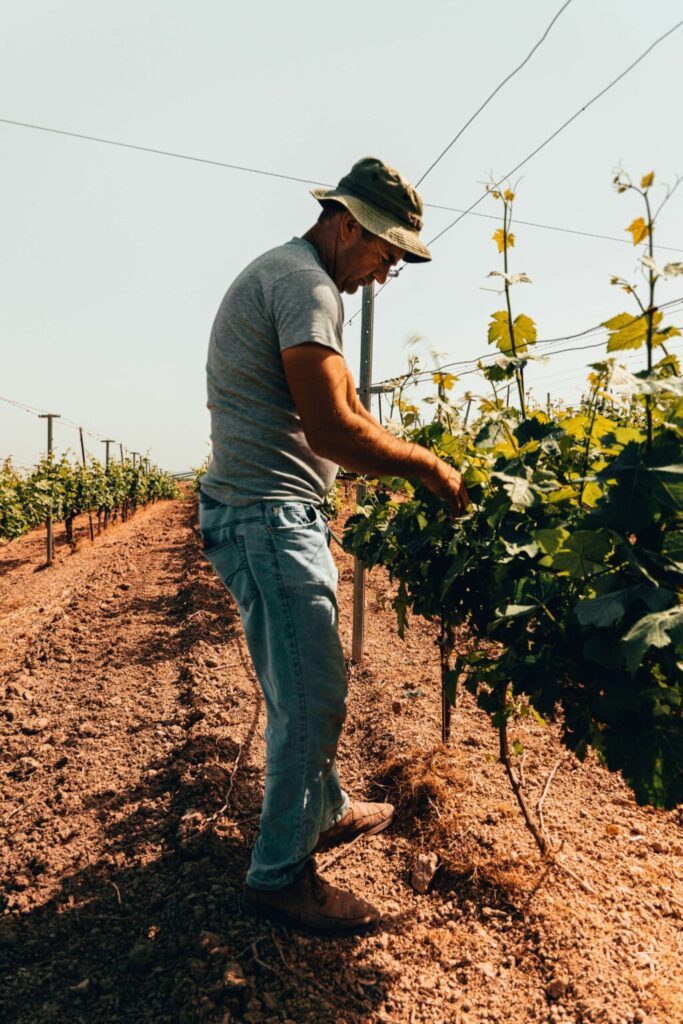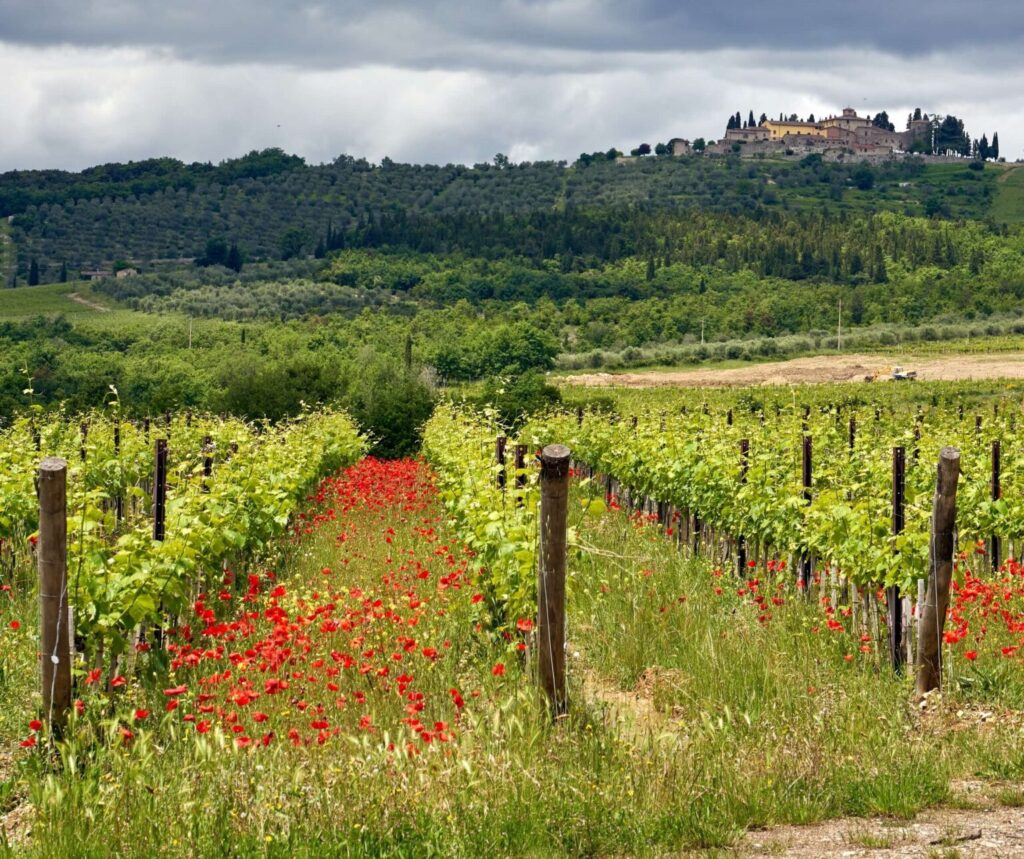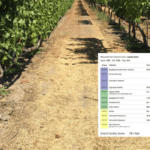An important part of growing winegrapes is also making business. While some growers concentrate only on the farming aspect and sell grapes to wineries, others process the grapes into wine or juice and sell it on-site, on the local market, and worldwide. No matter the business model, some vineyard farms generate more income than others, while some struggle for bare survival. Why is that so, and how can small family-owned vineyard farms improve their business?
Growing winegrapes is not just about producing the crop, but it’s also about making business.
Characteristics of small-family owned vineyard farms
About 75% of the world’s agricultural land is operated by family farms, and the grape wine industry is no exception. Families run most of the vineyards all around the world. Many family-owned vineyard farms are small scale farms, which is especially true for the “Old Wine World”. In 2015 the average vineyard area per holding in the EU was 1.3 ha (3.2 acres), with a big difference among member states. While the average vineyard area per holding in France was 10.5 ha (26 acres) in Greece, and Cyprus was only 0.6 ha (1.5 acres). In comparison, looking at the other side of the Atlantic, in California, where most of the US grapes are grown, in 2012, an average size per vineyard farm was 82 acres (33 ha), with variation among regions. In San Joaquin Valley, the average size was more than 140 acres (57 ha) of wine grapes per producer, while in North Coast an average producer was farming 38 acres (15 ha) of wine grapes.
As there are big differences in the average size of family-owned vineyard areas, plus several different types of family farms exist – from small subsistence-oriented family farms, small independent or dependent specialized farms, to large commercial family farms – this article focuses on small-family owned vineyard farms with the next characteristics:
- are run by a family
- most of the work is done by family members (with some additional help)
- the family owns most of the farmed property
- they produce for the market
- are highly motivated by survival (existence) and profit

Small family-owned vineyard farms business and ways to improve
Vineyard farm profitability depends on many different factors, weather and prices of agricultural products are certainly two of the critical external factors on which winegrowers have little to no effect. However, with good planning, a good economic result is possible. Although vineyards are associated with a relatively high investment (compared to annual crops), they can be very profitable. Winegrape growers have two options: selling grapes to cellars and brokers, or making their wine and selling it. Many vineyard owners open an onsite winery, despite significantly higher investment and operating costs, as this brings higher profits. Yet many times crop production alone does not guarantee survival, especially with small businesses due to lack of economy of scale. That’s why winegrowers opt for a complementary activity, such as distillation of spirits, juice production, vine grafting (nurseries), and tourism. But for all this, additional knowledge and resources are required. While growers have the technological expertise to produce grapes and make wines, they often lack other knowledge such as finances, planning, and marketing. When it comes to tourism, knowledge of marketing and hospitality can often be overwhelming, especially for small family-owned vineyard farms where just a few people do most of the job.
While some vineyard owners are struggling, others are improving their profit from year to year. There are as many different reasons for that as there are vineyard owners. As each farm is unique, there is no one answer to all – while one business model can bring fortune to one winegrower, it can be devastating for another. Therefore each vineyard owner has to find the right path. However, there is one thing that is often neglected, especially on small family-owned vineyard farms, and that is entrepreneurship. Due to rapidly changing environment and strong competition, small-scale farmes will have to become more entrepreneurial if they want to survive in the long term. This means that vineyard owners have to look for better ways to organize farm, find alternative technologies to increase productivity, diversify production, reduce risk, become more market-oriented and open new markets for their products, and thus increase profits. The key is to be innovative, forward-looking, and managing business as a long-term sustainable venture. Namely, the entrepreneurial families came to quality viticulture earlier and managed to export a significant amount of their products.
Entrepreneur is a person who produces for the market and always looking for opportunities to improve and expand the business. An entrepreneur always calculates risks, and accept responsibility for profits as well as for losses. He/She also has to be an innovator and look for better and more efficient and profitable ways to do things.
5 key points small family-owned vineyard farms should take into consideration to improve their business
Producing for the market
Since most of the money in farming is made after the product sale, in the case of winegrowing after the sale of either grapes or wines. Winegrowers need to start producing for buyers and final consumers and thus capture value within the value chain to increase profit. Just producing and selling is not enough anymore.
When it comes to small family-owned wineries, they are often very product and sales oriented, meaning they focus mostly on wine quality and assume that customers will come if the wine is good enough. While awards, competitions, and titles are the driving force of sales to whoever will buy the product, the more, the better. However, there are two other approaches to business: advertising orientation, which wineries have adopted in recent years with the boom of social media, and market orientation, which is often neglected. Market-oriented means being customer-centric and produce products that customers want (not the same as what you think your customers want). Customers should be put in the center (i.e., the customer is a king). Namely, winegrowers that are market-oriented can enjoy higher profitability, sales growth, and better customer retention. Thus an understanding of the wine market is the key. How can you achieve this? By analyzing the market in-depth and getting to know your customers. Going into a niche market and differentiated production is where you can capture more value.

The same goes for winegrowers that produce grapes and sell it to wineries, wine companies, or brokers. Get to know your grape buyer to understand what kind of grapes they are seeking. For example, if you know the winemaker wine style you are seeling to, you can adjust the vineyard management to match the winemaker’s requirements. That way, you can open an opportunity to develop a long-term relationship with the winery. Adjust the vineyard management for each vineyard block based on whom you are seeling to. Depending on who you are selling your grapes to, you may want to focus more on quantity or quality. And keep in mind that wineries are always looking for growers who have a reputation for growing good, consistent grapes and are establishing a name for themselves. You can even go niche by producing high-quality grapes for smaller wineries or even go organic if you have the knowledge and manage to find a buyer before conversion. To lower the risk, it’s often better to produce for several different buyers, or at least have a backup plan in case your main buyer goes bankrupt, decides to cancel the contract, or offer a way to low price. The COVID-19 pandemic has shown us how vulnerable the wine business can be.
Acquiring new technologies and innovation
Another way to change the production system is to develop or adopt new technologies and practices in order to cut costs and increase efficiency. New technologies are developing all the time, and although in the past, larger commercial farms were more likely to rely on modern technology to maximize the efficiency of the management process, nowadays, several solutions exist also for smaller winegrowers. From equipment for cultivation, harvesting, and wine processing, to special software programs designed to keep track of grape production, calculate costs, and simplify several management tasks. One such software is also eVineyard Lite, specially designed for small family-owned winegrowers to help with vineyard management – from lowering the number of spraying, optimizing irrigation, and planning work, to creating documentation. You can now try it for free here.
Sustainable winegrowing
Grape growing is associated with long-term land use, and as long the land is productive, the profits will continue. Namely, unsustainable land use has a long-term negative effect on business. With re-investing part of the profit into soil fertility, conservation of natural resources, and the use of sustainable products and technologies will enable you to stay in business for a long time. This does not necessarily mean you need to apply to sustainability scheme or go organic, but take care of the soil – increase soil organic matter, use fewer pesticides and replace them with more sustainable ones – integrated pest management is a good first start, start using fewer natural resources such as water, etc. You know how it goes – what goes around, comes around,- and hardly somewhere is this more true than in farming.

Getting new knowledge
Only with constant learning and acquiring new knowledge, you can be successful in the fast-changing market. Following and making use of the latest technological knowledge to produce agricultural products is important. But as winegrowing is not only about crop production but also about making business, farm management skills such as marketing, risk management, financial management, and labor management are equally important. Knowlege every family-owned vineyard farm must have and should develop over time for successful work is:
- technological knowledge of crop production
- basic management knowledge (economics, farm organization)
- product marketing knowledge and skills
- knowledge of informatics, system analysis, etc.
The latest will be even more crucial in the future with the development of new precision viticulture technologies.
Managing farm according to a long-term plan
If you want to be successful, you need to be strategic in your planning and implementation, namely strategic management is necessary to position business for the future. Look at your winegrape business from a broad and long-term view. Having a strategy will help you make short-term decisions in line with long-term goals, also in uncertain situations.
A strategy is an overall long-term plan for the farm business. It sets out the goals that farmers wants to achive and the main ways to achive those goals.
There are many ways small family-owned vineyard farms can increase profits and create value: from diversifying (increase the source of income and mitigate risks – increasing the number of products, producing for different entities), lowering costs (finding less expensive resources and inputs and using more efficient production system), expanding the business size (if your farm is already profitable and competitive, you may want to have more land under the crop, or modernized production, so that is more efficient), specializing (developing products to meet specific market demands), differentiating the products (production and marketing are different from competitors, so that product matches buyers preferences), etc.
To choose the most appropriate business strategy, you need to:
- first identify the farm’s long-term goals,
- define the limited means of production,
- search for alternatives and analyze them (in terms of inputs, labor costs, and revenue),
- then decide on an individual production,
- implement the decision,
- and evaluate the results.
Conclusion
While some family-owned vineyard business perform very well, others are struggling. There are numerous different reasons why some succeed while others don’t – long-term strategy, commitment, and entrepreneurship are definitely the key to success. Entrepreneurial farmers are focused on their goals and actively looking for solutions, new knowledge, and skills, and are willing to embrace change. Yet, study results suggested that family businesses’ growth tends more towards family reasons than towards business reasons. And that winegrowers are more risk-averse when emotional wealth is threatened. Suggesting that family-owned winegrowers have lots’ of places for improvement when it comes to making business and profit. The Coronavirus pandemic shows how vulnerable the wine industry is, and while winegrowers that have a long-term strategy in place were able to make fast decisions and adapt to the new reality, we see that many were slower and not sharp enough in their response. So if you don’t have a strategy in place, now is the best time to start making a change – one step at a time will do.
Sources:
- D. Kahan. 2012. Entrepreneurship in farming. FAO, Rome 2012.
- Why Being Market-Driven Is Good For Business; by Reka Haros on Reframe Wine (online)
- 12 tips for selling to multiple wineries; by Melissa Hansen on Good Fruit Grower (online)
- Family business on a grand scale – Family owned wineries in Italy; by Matthias Stelzig on ProWein (online)
- J. M. Alston, J. T. Lapsley, and O. Sambucci. 2018. Grape and Wine Production in California. In California Agriculture: Dimensions and Issues, University of California, Giannini Foundation of Agricultural Economics.
- Č. Rozman et. al. 2009. Menedžment v kmetijstvu. Slovenj Gradec: Kmetijska založba, 2009.
- Featured image: by Bertrand Bouchez on Unsplash




